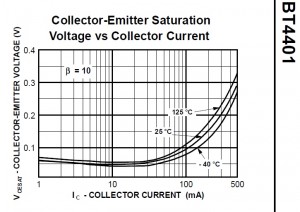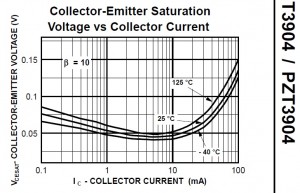
 Peter asked me why the Joule Thief transistor’s Vce(sat) is important. I will try to make an analogy of the current in a transistor to the flow of water in a pipe. In a JT, the transistor is supposed to be like a switch: it’s on (like a short) or off (like an open). But the current flow through the transistor is like the flow of water through a pipe. If the pipe is large diameter, then the flow is not restricted. But if the pipe is small, then the flow is restricted, and there is a difference of pressure (voltage) between the top end of the pipe (the transistor’s collector) and the bottom end of the pipe (the transistor’s emitter).
Peter asked me why the Joule Thief transistor’s Vce(sat) is important. I will try to make an analogy of the current in a transistor to the flow of water in a pipe. In a JT, the transistor is supposed to be like a switch: it’s on (like a short) or off (like an open). But the current flow through the transistor is like the flow of water through a pipe. If the pipe is large diameter, then the flow is not restricted. But if the pipe is small, then the flow is restricted, and there is a difference of pressure (voltage) between the top end of the pipe (the transistor’s collector) and the bottom end of the pipe (the transistor’s emitter).
The Vce(sat) is the value, often found in a chart, that is given when you read the specifications in the transistor’s data sheet. It’s like an indication of the size of the pipe between the emitter and collector of the transistor. If the transistor is capable of handling 200 mA with a voltage drop of a quarter volt, then it has a smaller pipe that will have a higher voltage drop when it is turned on (saturated).
If you search for the 2N3904 datasheet from Fairchild (it’s a .PDF) and view the page with the graphs, you will see a graph (see the attached picture) named “Collector-Emitter Saturation Voltage vs Collector Current”. The graph has three lines: one for high temp, one for room temp, and one for cold temps. The only one we’re interested in is the room temp line. You will notice that this line has a saddle shape, with fast rise towards the right side. If the transistor was a resistor, the line would be a straight line, but it is not a resistor, it is a semiconductor, and has a non-linear voltage-current line.
Also notice that in the corner of the graph it says “β=10”. This means that the transistor is saturated, causing the beta to be forced to 10 . Some higher current gain transistors may use 20 or 30 but they are still saturated.
Notice that the graph ends at 100 mA on the right side, implying that the 2N3904 was not meant to be operated at more than 100 milliamps. However, in the absolute maximum ratings on the first page, it gives 200 mA as the absolute maximum current rating. A normal Joule Thief requires much more than 200 milliamps peak, and this exceeds the 2N3904’s absolute maximum ratings. But if you guesstimate the point off the right hand edge of the graph, the Vce(sat) will be greater than 1/4 volt when the current exceeds 200 mA. When the Vce(sat) is greater than 1/4 volt, the loss becomes excessive, and more power is wasted in the transistor and does not get to the LED. That is why I do not recommend using the 2N3904 for a JT. Instead use a PN2222, 2N4401 or BC337-25, which cost the same or less than the 2N3904 (see note below).
Back to the graph. What you want to see is a graph that shows the Vce(sat) less than 1/4 volt at a current above 200 mA, and preferably at currents above 500 milliamps. The transistors I gave above can meet this requirement. Check their specifications and/or graph, and you will see the difference. The other better transistors (for a JT) can handle much more than 1 amp. The 2SD965, 2SD5041, 2SC2500, SS8050, NTE11 can do this. You can see from the graph for the 2N4401 that it is capable of handling about 300 mA at 1/4 volt Vce(sat), which is much better than the 2N3904.
Note: Looking at the specifications for the 2N3904, we can see that it is meant to operate at a few tens of milliamps or less, and has low noise so it can be used as an amplifier. In order to get good high speed performance, the size of the 2N3904’s chip is kept small, so it doesn’t have the high current carrying capability of the PN2222, 2N4401 or BC337. Save your 2N3904s (and BC547s) for amplifiers and low current switches – they work great for this. Use the other transistors for the Joule Thief.